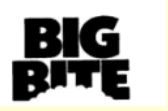BIG BITE vs. BIT BITE.
These two marks were assessed in the recent case of 7-Eleven, Inc v BitBite Foods Inc. , 2014 TMOB 16 (CanLII), for snack food products. BitBite Foods filed an application to register the BIT BITE design at right in connection with a variety of food products. 7-11 opposed the application on the basis of their family of BIG BITE marks, including BIG BITE (TMA728,674), 1/3 LB. BIGGEST BIG BITE (TMA593,755), SMOKIE BIG BITE (TMA393,436), and SUPER BIG BITS (TMA602,497), also in association with food products. The 7-11 marks included the BIG BITE Design (TMA405,449) at left.


Essentially, both marks were associated with food products, both marks featured a stylized "bite" design element, and the marks were virtually identical except for a single letter. 7-11 argued that their marks were all registered and had been used in Canada since the 1990s. The BIT BITE mark by comparison was applied for on the basis of "proposed use" meaning it has not yet been used in Canada.
How did the court decide this case?
The test for trade-mark confusion in Canada is one of "first impression and imperfect recollection." The Trade-marks Act is clear that confusion will result if two trade-marks are used in the same area and would lead a consumer to infer that the products sold under the two marks are manufactured or sold by the same company. Courts in Canada will assess a number of factors when judging two marks:
- the distinctiveness of the two marks
- the length of time each mark has been in use
- the nature of the products or business
- the nature of the trade
- the degree of resemblance between the two trade-marks in appearance and sound or in the connotations.
It is important to note that these factors are not an exhaustive list, and courts are not obliged to give each factor equal weight. The court in this case assessed these factors and also weighed the state of the Register and the state of the relevant marketplace.
After assessing all of these factors, the court concluded that marks do share similarities in appearance and when sounded, but the judge "found a significant difference between the parties' marks as a whole, in ideas suggested; a difference, given the simplistic nature of the word components of the parties' marks, that is readily apparent to the average consumer. "... and the 7-11 "BIG BITE marks are not inherently strong and that the evidence clearly demonstrates that the words BIG and BITE are commonly used in the trade" ...therefore "the differences between the parties' marks [are] sufficient to distinguish them."
7-11's opposition was dismissed. One letter was enough of a difference in this case.
The content of this article is intended to provide a general guide to the subject matter. Specialist advice should be sought about your specific circumstances.
